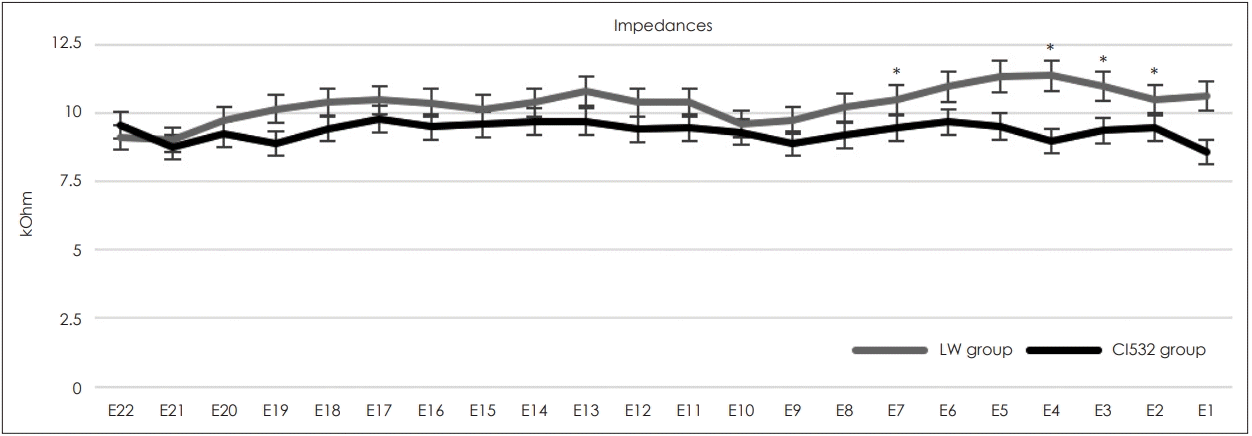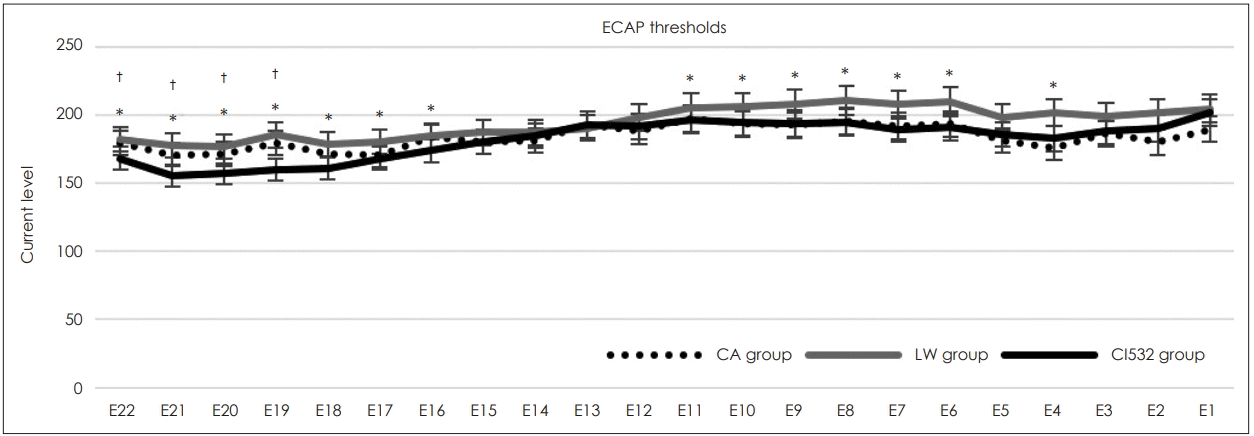1. Hey M, Wesarg T, Mewes A, Helbig S, Hornung J, Lenarz T, et al. Objective, audiological and quality of life measures with the CI532 Slim Modiolar electrode. Cochlear Implants Int. 2019; 20(2):80–90.

2. Lazard DS, Vincent C, Venail F, Van de Heyning P, Truy E, Sterkers O, et al. Pre-, per- and postoperative factors affecting performance of postlinguistically deaf adults using cochlear implants: A new conceptual model over time. PLoS One. 2017; 7(11):e48739.

3. Kim LS, Lee MY, Heo MJ, Oh YJ. Long-term development of auditory performance in children with cochlear implants. Korean J Otolaryngol-Head Neck Surg. 2002; 45(1):18–21.
4. Kim JR, Shin BS. The relationship between electrically evoked compound action potential and speech perception in CI24RE implant users. Korean J Otorhinolaryngol-Head Neck Surg. 2010; 53(8):470–4.

5. Lehnhardt E. [Intracochlear placement of cochlear implant electrodes in soft surgery technique]. HNO. 1993; 41(7):356–9.
6. Park S, Choi JY. A case of electric acoustic stimulation cochlear implantation in partial deafness with residual low-frequency hearing. Korean J Otorhinolaryngol-Head Neck Surg. 2012; 55(11):712–6.

7. Jang JH, Lee SH. Updates in prognostic factors of cochlear implantation. Korean J Otorhinolaryngol-Head Neck Surg. 2014; 57(11):738–47.

8. Jeong J, Kim M, Heo JH, Bang MY, Bae MR, Kim J, et al. Intraindividual comparison of psychophysical parameters between perimodiolar and lateral-type electrode arrays in patients with bilateral cochlear implants. Otol Neurotol. 2015; 36(2):228–34.

9. Lathuillière M, Merklen F, Piron JP, Sicard M, Villemus F, Menjot de Champfleur N, et al. Cone-beam computed tomography in children with cochlear implants: The effect of electrode array position on ECAP. Int J Pediatr Otorhinolaryngol. 2017; 92:27–31.

10. Wackym PA, Firszt JB, Gaggl W, Runge-Samuelson CL, Reeder RM, Raulie JC. Electrophysiologic effects of placing cochlear implant electrodes in a perimodiolar position in young children. Laryngoscope. 2004; 114(1):71–6.

11. Patrick JF, Busby PA, Gibson PJ. The development of the Nucleus Freedom Cochlear implant system. Trends Amplif. 2006; 10(4):175–200.

12. Ahn JH, Oh SH, Chung JW, Lee KS. Facial nerve stimulation after cochlear implantation according to types of Nucleus 24-channel electrode arrays. Acta Otolaryngol. 2009; 129(6):588–91.

13. Wanna GB, Noble JH, Carlson ML, Gifford RH, Dietrich MS, Haynes DS, et al. Impact of electrode design and surgical approach on scalar location and cochlear implant outcomes. Laryngoscope. 2014; 124 Suppl 6(0 6):S1–7.

14. Kim YR, Yoo MH, Lee JY, Yang CJ, Park JW, Kang BC, et al. Characteristics and pathogenesis of facial nerve stimulation after cochlear implant surgeries: A single-centre retrospective analysis from 1151 patients. Clin Otolaryngol. 2018; 43(5):1396–400.

15. Briggs RJ, Tykocinski M, Lazsig R, Aschendorff A, Lenarz T, Stöver T, et al. Development and evaluation of the modiolar research array--multi-centre collaborative study in human temporal bones. Cochlear Implants Int. 2011; 12(3):129–39.
16. Park LR, Teagle HFB, Brown KD, Gagnon EB, Woodard JS, Buchman CA. Audiological outcomes and map characteristics in children with perimodiolar and slim straight array cochlear implants in opposite ears. Otol Neurotol. 2017; 38(9):e320–6.

17. McJunkin JL, Durakovic N, Herzog J, Buchman CA. Early outcomes with a slim, modiolar cochlear implant electrode array. Otol Neurotol. 2018; 39(1):e28–33.

18. van Dijk B, Botros AM, Battmer RD, Begall K, Dillier N, Hey M, et al. Clinical results of AutoNRT, a completely automatic ECAP recording system for cochlear implants. Ear Hear. 2007; 28(4):558–70.

19. Venail F, Mura T, Akkari M, Mathiolon C, Menjot de Champfleur S, Piron JP, et al. Modeling of auditory neuron response thresholds with cochlear implants. Biomed Res Int. 2015; 2015:394687.

20. Balkany TJ, Connell SS, Hodges AV, Payne SL, Telischi FF, Eshraghi AA, et al. Conservation of residual acoustic hearing after cochlear implantation. Otol Neurotol. 2006; 27(8):1083–8.

21. Skarzynski H, van de Heyning P, Agrawal S, Arauz SL, Atlas M, Baumgartner W, et al. Towards a consensus on a hearing preservation classification system. Acta Otolaryngol Suppl. 2013; (564):3–13.

22. Aschendorff A, Briggs R, Brademann G, Helbig S, Hornung J, Lenarz T, et al. Clinical investigation of the Nucleus Slim Modiolar electrode. Audiol Neurootol. 2017; 22(3):169–79.

23. Friedmann DR, Kamen E, Choudhury B, Roland JT Jr. Surgical experience and early outcomes with a slim perimodiolar electrode. Otol Neurotol. 2019; 40(3):e304–10.

24. Gordon KA, Papsin BC. From nucleus 24 to 513: Changing cochlear implant design affects auditory response thresholds. Otol Neurotol. 2013; 34(3):436–42.
25. Gordin A, Papsin B, James A, Gordon K. Evolution of cochlear implant arrays result in changes in behavioral and physiological responses in children. Otol Neurotol. 2009; 30(7):908–15.

26. Perenyi A, Toth F, Dimak B, Nagy R, Schoerg P, Jori J, et al. Electrophysiological measurements with electrode types of different perimodiolar properties and the same cochlear implant electronics - a retrospective comparison study. J Otolaryngol Head Neck Surg. 2019; 48(1):46.

27. Clark GM, Shute SA, Shepherd RK, Carter TD. Cochlear implantation: Osteoneogenesis, electrode-tissue impedance, and residual hearing. Ann Otol Rhinol Laryngol Suppl. 1995; 166:40–2.
28. Shaul C, Bester CW, Weder S, Choi J, Eastwood H, Padmavathi KV, et al. Electrical impedance as a biomarker for inner ear pathology following lateral wall and peri-modiolar cochlear implantation. Otol Neurotol. 2019; 40(5):e518–26.

29. Kawano A, Seldon HL, Clark GM, Ramsden RT, Raine CH. Intracochlear factors contributing to psychophysical percepts following cochlear implantation. Acta Otolaryngol. 1998; 118(3):313–26.
30. Nadol JB Jr, Eddington DK, Burgess BJ. Foreign body or hypersensitivity granuloma of the inner ear after cochlear implantation: One possible cause of a soft failure? Otol Neurotol. 2008; 29(8):1076–84.

31. Cuda D, Murri A. Assessment of cochlear trauma and telemetry measures after cochlear implantation: A comparative study between Nucleus® CI512 and CI532 electrode arrays. Audiol Res. 2019; 9(1):223.

32. Skarzynski H, van de Heyning P, DeMin H, Li Y, Bo L, Caversaccio M, et al. Hearing Preservation Classification. J Hear Sci. 2012; 2(2):95–6.
33. Ramos-Macías A, Borkoski-Barreiro SA, Falcón-González JC, Ramos-de Miguel A. Hearing preservation with the Slim Modiolar Electrode Nucleus CI532® cochlear implant: a preliminary experience. Audiol Neurootol. 2017; 22(6):317–25.

34. Lenarz T, Stöver T, Buechner A, Lesinski-Schiedat A, Patrick J, Pesch J, et al. Hearing conservation surgery using the Hybrid-L electrode. Results from the first clinical trial at the Medical University of Hannover. Audiol Neurootol. 2009; 14 Suppl 1:22–31.
35. Gantz BJ, Dunn C, Oleson J, Hansen M, Parkinson A, Turner C. Multicenter clinical trial of the Nucleus Hybrid S8 cochlear implant: Final outcomes. Laryngoscope. 2016; 126(4):962–73.

36. Roland JT Jr, Gantz BJ, Waltzman SB, Parkinson AJ; Multicenter Clinical Trial Group. United States multicenter clinical trial of the cochlear nucleus hybrid implant system. Laryngoscope. 2016; 126(1):175–81.

37. Cuda D, Murri A. Cochlear implantation with the Nucleus Slim Modiolar electrode (CI532): A preliminary experience. Eur Arch Otorhinolaryngol. 2017; 274(12):4141–8.








 PDF
PDF Citation
Citation Print
Print




 XML Download
XML Download